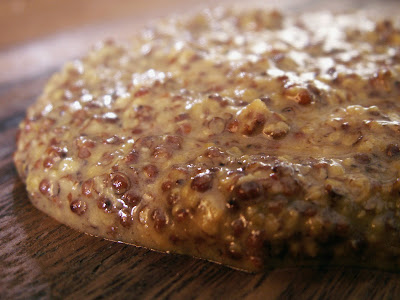| From Daube Creole |
Daube was introduced to New Orleans by the French Creoles who brought the preparation from their native France, where there are many regional versions of the dish. The Creoles went a step further and created Daube Glace which is a jellied dish served cold for breakfast or brunch.
What makes this dish unique from an ordinary Pot Roast is the larding of the roast with seasoned salt pork which flavors the meat from the inside while it cooks. Be sure and do this the night before cooking!
I use a split pig’s foot in the preparation of Daube Creole for the gelatin and richness that it adds to the sauce, also important for making Daube Glace.
| From Daube Creole |
Larded Beef Roast Recipe
5 lb Beef Roast, preferably from the Round
1/4 lb Salt pork fat, cut into thin strips (1/2″ X 3″)
1 Tbsp Parsley, finely chopped
1 Tbsp Fresh Thyme, finely chopped
3 Fresh Bay Leaves, very finely chopped
4 Garlic Cloves, minced
2 Tbsp Spanish Onion, minced
1/8 tsp Ground Cloves
2 Tbsp Diamond Crystal Kosher Salt
1 Tbsp Freshly Grated Black Pepper
Make 1 inch long incisions about 3 inches deep all over the roast. Toss the salt pork strips with the remaining ingredients.
| From Daube Creole |
Fill each incision with some of the seasoned salt pork mixture. Refrigerate overnight.
| From Daube Creole |
Daube Creole Recipe
3 Tbsp Lard or Bacon drippings
1 5 lb Larded Beef Round (recipe above)
Kosher Salt
Black Pepper
All Purpose Flour for dusting
1 Large Spanish Onion, chopped
3 Tbsp Tomato Paste
1 Cup Dry Sherry
2 Quarts Beef Stock
5 Carrots, cut into 1/2″ dice
2 Turnips, cut into 1/2″ dice
4 Cloves Garlic, minced
1 Pork Foot, split
3 Bay Leaves
1 Bunch Fresh Thyme, tied
Season the larded roast very liberally with salt and black pepper and dust lightly all over with the flour. Heat the lard in a large Dutch Oven on high heat. When very hot, sear the larded roast on all sides until very brown. Remove the roast to a plate.
| From Daube Creole |
Reduce the heat to medium and add the onion, stirring well, making sure to get all of the brownings from the bottom of the pot. When the onion is nicely browned add the tomato paste. Cook for several minutes, browning the paste slightly. Add the sherry and bring to a boil over high heat to cook off the alcohol.
Add the stock, carrots, turnips, garlic, split pig’s foot, bay leaves and thyme. Bring to a boil, then return the roast to the pot, turn the heat down to a simmer.
| From Daube Creole |
Cover the pot with a tight fitting lid and cook for 3 1/2 to 4 hours.
When the roast is tender remove to a cutting board. Turn up the heat and reduce the sauce by half. Remove the pig’s foot, bay leaves, and thyme. Season to taste with salt, black pepper and cayenne. Add the chopped parsley.
Slice the roast in thin slices and cover generously with the sauce. Serve over Creole Boiled Rice or cooked pasta.
Serves 6-8.




